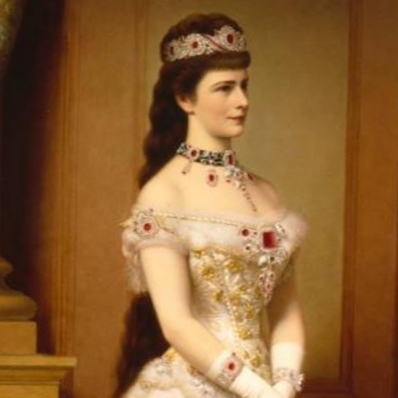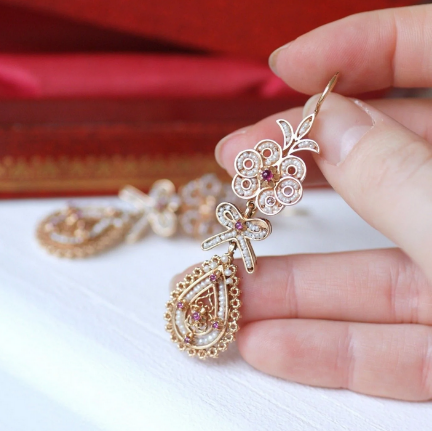While its name comes from the Latin rubeus meaning red, in Sanskrit the ruby is called ratnanayaka, meaning "king of gems". Born in July, it's your birthstone.
So for your birthday, we're not taking you to Disneyland or La La Land (well, if Ryan wants to come, that's ok) but to... Ruby land!

The ruby belongs to the corundum family of minerals, just like another gem from the select club des 4... do you have it? It is the sapphire of course! The latter can be any colour of the rainbow, while the ruby is always red.

Burmese ruby and diamond garter ring
Sapphire or ruby: the differences
What differentiates ruby from sapphire is its colour. Red, of course, but in an infinite number of shades, which means that there can sometimes be a conflict between ruby and pink sapphire. It is the presence of chromium in the stone that gives it its carmine colour, while iron tends to darken the gem by giving it a violet tinge. The most beautiful rubies are often found in deposits rich in white marble, such as the Burmese pigeon blood ruby, which has a very sought-after deep red colour. Their special feature is that they are iron-free, unlike other metamorphic rocks in which rubies can also be found. The red gemstone also has the property of being dichroic, i.e. it has variations in colour: depending on the angle of observation and the light, it can turn either purple or orange.

Pink Sapphire and Diamond Ring
Finally, did you know that, like sapphires, there are also star rubies? When these specific gems, once cut into cabochons, are illuminated by electric light, a six-pointed star, more rarely a twelve-pointed star, forms on their surface. This asterism is due to the presence of rutile needles, natural inclusions, in the stone.
You can admire the 138-carat Rosser Reeves at the Smithsonian Institute. Together with the diamond hope andaquamarine Dom Pedro, here's a third reason to visit the Washington Museum of Natural History!

Rosser Reeves star ruby, Washington D.C., Smithsonian Institute.
Ruby land: the origin of ruby
Did you think Ruby land was our invention? We're flattered that you're praising our imagination, but not at all: Ruby land, or Mogok Ruby Valley, is a sixteen square kilometre area in the Burmese jungle. It is the land of plenty for our red stone, even if rubies have become very scarce in recent years. Moreover, we have already discussed in our articles the notion of a more sexy, often historical, provenance for certain gems. It is for example Colombia for the emeraldKashmir for the sapphire and as far as the ruby is concerned, we give it to you in thousand... Burma of course! Moreover, the ruby being rare, with equivalent quality it would be worth more money than the colourless diamond. In other words, if you own a pigeon-blooded Burmese ruby, you've hit the jackpot.

Birman Ruby Ring Surrounded by Diamonds
There are obviously other origins. The most beautiful rubies, from deposits rich in white marble, come from Tajikistan, Vietnam and Afghanistan, in addition to Burma. The red stone is also found in Thailand, Tanzania, Mozambique and Madagascar.
Ruby beliefs and meanings
The myth of the Valley of the Rubies is told in Joseph Kessel's book of the same name. He writes:
"Legend has it that in time immemorial a giant eagle, flying over the world, found in the vicinity of Mogok a huge stone, which it at first took to be a piece of living flesh, so much so that it was the colour of the most generous and purest blood. It was a kind of sunshine. The eagle carried the first ruby of the universe to the sharpest peak of the valley. Thus was born Mogok.
The ruby, as can be seen here, is closely linked to life in its carnal aspect. It is not for nothing that the deepest shade of ruby, characteristic of Mogok, is called pigeon's blood!

The red stone was very popular in the 18th and 19th centuries. It is often combined with fine pearls or diamonds to highlight its colour. The ruby is also the gem of love and sensual fever, so much so that in the Victorian era it was considered unseemly for a young girl to wear a jewel adorned with rubies. Sapphires were therefore favoured before marriage, as shown by the brooch given by Prince Albert to the Queen Victoria. Napoleon III, for his part, paid little attention to Victorian decorum and declared his love for the future Empress Eugenie with a heart-shaped medallion decorated with rubies and diamonds containing a lock of her hair, made by Chaumet.

CHAUMET, Gold medallion, ruby, diamonds, glass and hair, Private collection.
It was also thought in ancient times that the ruby protected against lightning. Good news if you haven't managed to avoid being struck by lightning, it turns out that the ruby celebrates thirty-five years of marriage!
Finally, among the Mughals, the ruby is traditionally and symbolically associated with power because of its colour: red is indeed the colour of royalty and empire. This is also the case with us where red is the colour of sovereignty, and we don't want to snitch, but did you know that Prince Edward's "ruby" which adorns the English crown is in fact... a spinel?

If you want to know more about the symbolism of red in the West we invite you to read our article Blushing with pleasure.
Rest assured, however, that rubies can be found in crown jewels and other imperial finery, such as that of Elisabeth of Austria. Sissi wears it here on her last portrait, made on the occasion of her silver wedding with Franz Joseph I.

Empress Elisabeth of Austria in 1879. Portrait by George Raab (detail).
Tiara, necklace, brooches, bracelets and corsage ornaments... but earrings are missing! Would you like some more rubies ?

Drop earrings, pearls and rubies on rose gold
Play it in total-look like Sissi with our full selection in the drop-down menu on the right, or below for the mobile version.
Don't be jealous if you were not born in July, find out here your birthstone.
bague-ancienne-jarretiere-rubis-diamant: bague coeur rubis birman: bague-ancienne-bandeau-or-rubis-diamants: bague-jarretiere-or-rubis-birman-diamant: bracelet jonc croise rubis: bague-ancienne-marguerite-rubis-birman-diamant: marguerite xs birman: bague-ancienne-fer-a-cheval-or-jaune-rubis: bague-de-fiancailles-marguerite-rubis-diamants: bague-ancienne-bandeau-or-rubis-diamants
